University PMBOK Risk Management Report: Agile, Bible, and Processes
VerifiedAdded on 2022/10/13
|9
|1803
|15
Report
AI Summary
This report provides a comprehensive overview of PMBOK risk management, focusing on its knowledge areas and process groups. It delves into the ten knowledge areas, with a specific emphasis on risk management, and outlines the five process groups: initiation, planning, execution, monitoring and controlling, and closing. The report explores the adaptation of risk management within agile and adaptive methodologies, highlighting considerations for project managers and teams. Furthermore, it integrates biblical principles, drawing parallels between biblical examples and the application of risk management in contemporary business settings. The report concludes by emphasizing the importance of risk management in ensuring project success, referencing scholarly resources to support its findings. The report is formatted in APA and adheres to the provided assignment brief.
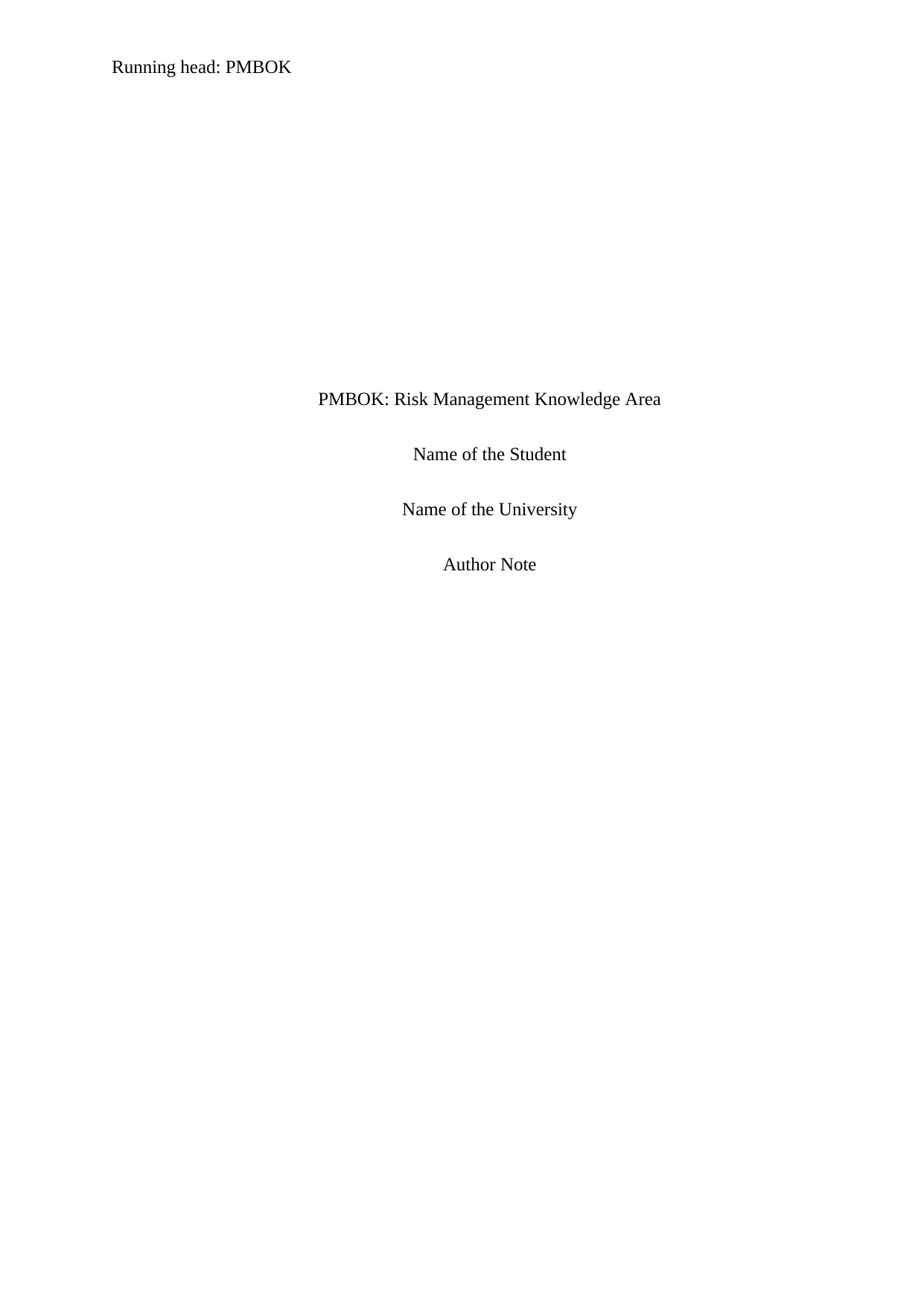
Running head: PMBOK
PMBOK: Risk Management Knowledge Area
Name of the Student
Name of the University
Author Note
PMBOK: Risk Management Knowledge Area
Name of the Student
Name of the University
Author Note
Paraphrase This Document
Need a fresh take? Get an instant paraphrase of this document with our AI Paraphraser
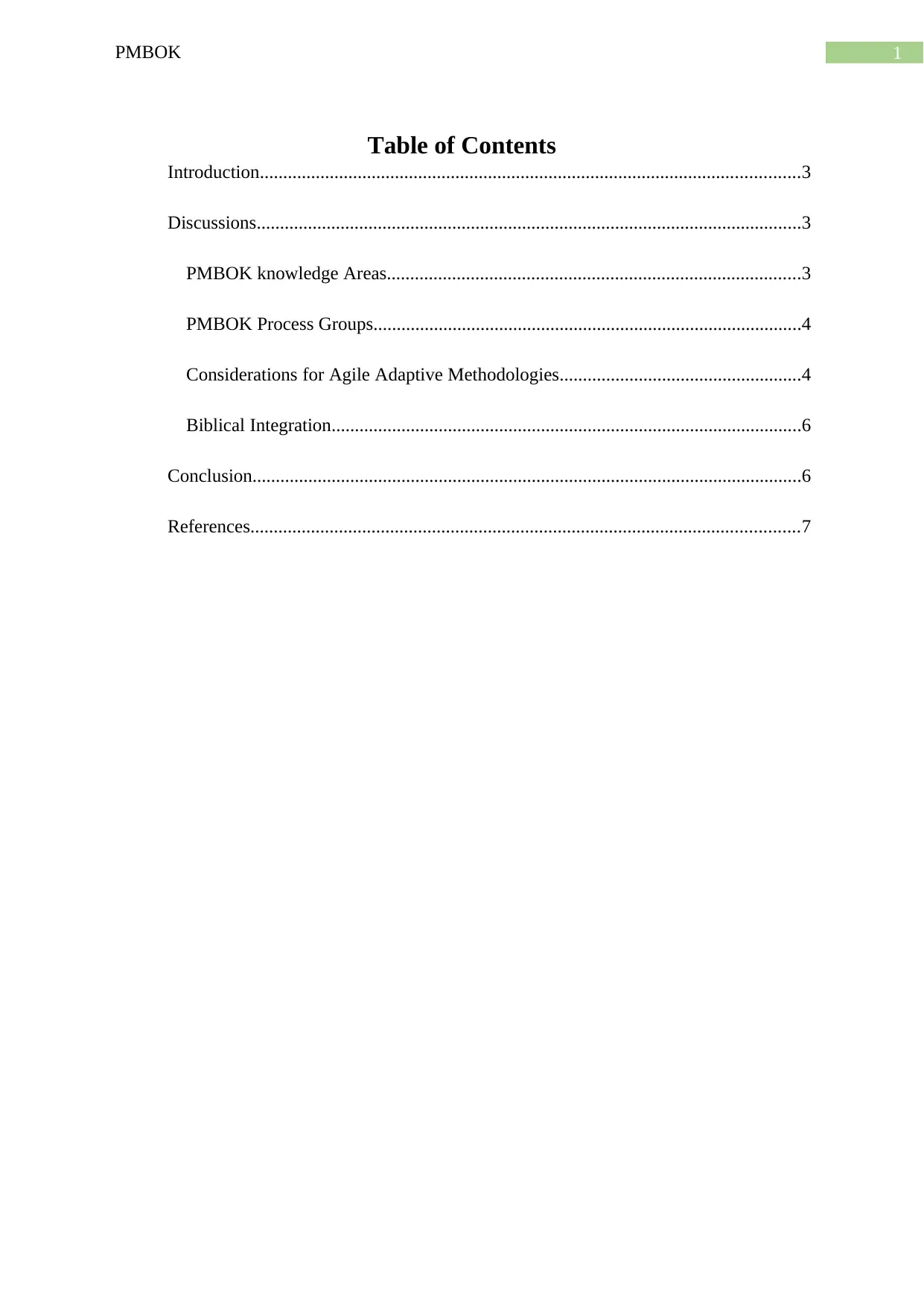
1PMBOK
Table of Contents
Introduction....................................................................................................................3
Discussions.....................................................................................................................3
PMBOK knowledge Areas.........................................................................................3
PMBOK Process Groups............................................................................................4
Considerations for Agile Adaptive Methodologies....................................................4
Biblical Integration.....................................................................................................6
Conclusion......................................................................................................................6
References......................................................................................................................7
Table of Contents
Introduction....................................................................................................................3
Discussions.....................................................................................................................3
PMBOK knowledge Areas.........................................................................................3
PMBOK Process Groups............................................................................................4
Considerations for Agile Adaptive Methodologies....................................................4
Biblical Integration.....................................................................................................6
Conclusion......................................................................................................................6
References......................................................................................................................7
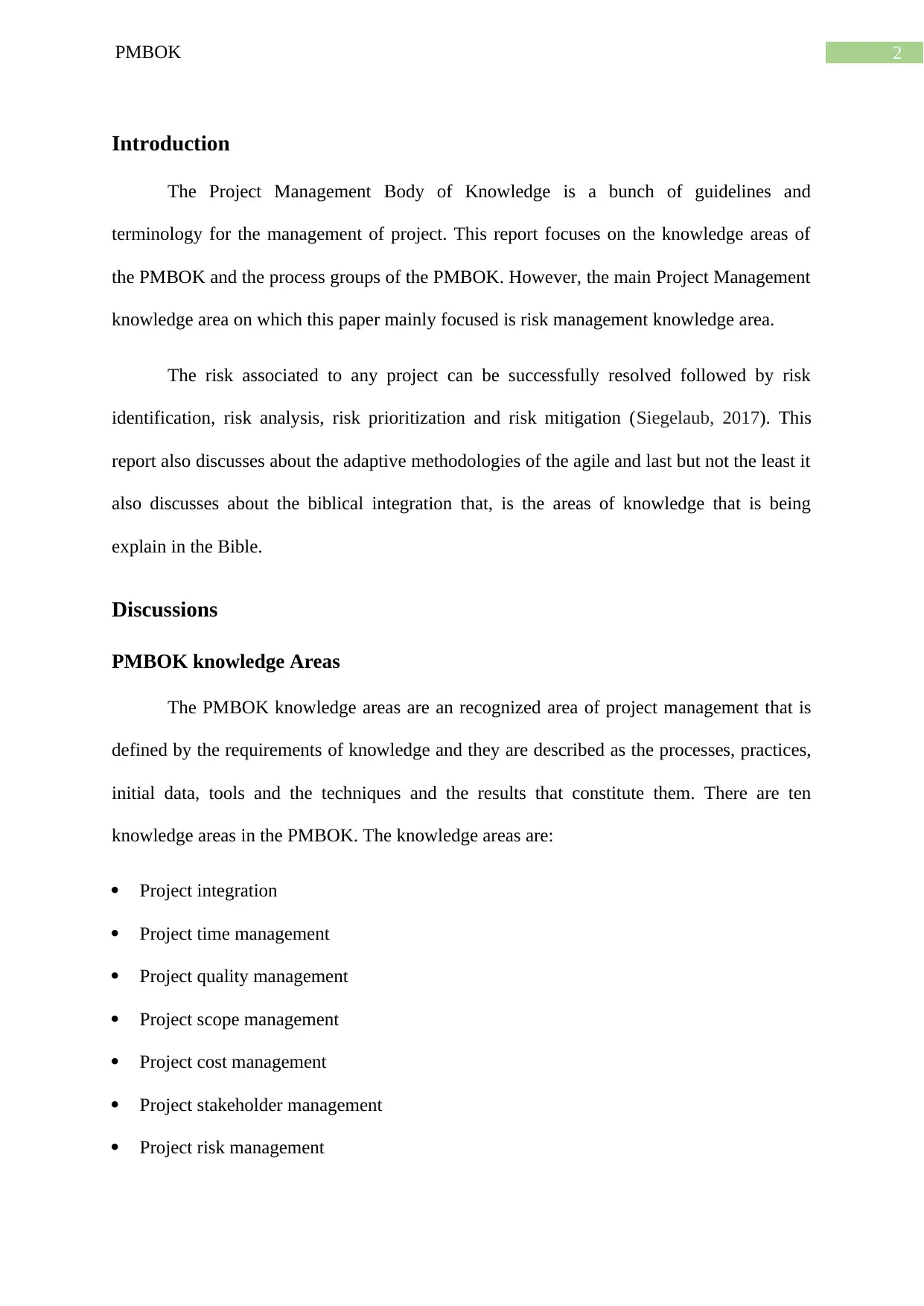
2PMBOK
Introduction
The Project Management Body of Knowledge is a bunch of guidelines and
terminology for the management of project. This report focuses on the knowledge areas of
the PMBOK and the process groups of the PMBOK. However, the main Project Management
knowledge area on which this paper mainly focused is risk management knowledge area.
The risk associated to any project can be successfully resolved followed by risk
identification, risk analysis, risk prioritization and risk mitigation (Siegelaub, 2017). This
report also discusses about the adaptive methodologies of the agile and last but not the least it
also discusses about the biblical integration that, is the areas of knowledge that is being
explain in the Bible.
Discussions
PMBOK knowledge Areas
The PMBOK knowledge areas are an recognized area of project management that is
defined by the requirements of knowledge and they are described as the processes, practices,
initial data, tools and the techniques and the results that constitute them. There are ten
knowledge areas in the PMBOK. The knowledge areas are:
Project integration
Project time management
Project quality management
Project scope management
Project cost management
Project stakeholder management
Project risk management
Introduction
The Project Management Body of Knowledge is a bunch of guidelines and
terminology for the management of project. This report focuses on the knowledge areas of
the PMBOK and the process groups of the PMBOK. However, the main Project Management
knowledge area on which this paper mainly focused is risk management knowledge area.
The risk associated to any project can be successfully resolved followed by risk
identification, risk analysis, risk prioritization and risk mitigation (Siegelaub, 2017). This
report also discusses about the adaptive methodologies of the agile and last but not the least it
also discusses about the biblical integration that, is the areas of knowledge that is being
explain in the Bible.
Discussions
PMBOK knowledge Areas
The PMBOK knowledge areas are an recognized area of project management that is
defined by the requirements of knowledge and they are described as the processes, practices,
initial data, tools and the techniques and the results that constitute them. There are ten
knowledge areas in the PMBOK. The knowledge areas are:
Project integration
Project time management
Project quality management
Project scope management
Project cost management
Project stakeholder management
Project risk management
⊘ This is a preview!⊘
Do you want full access?
Subscribe today to unlock all pages.

Trusted by 1+ million students worldwide
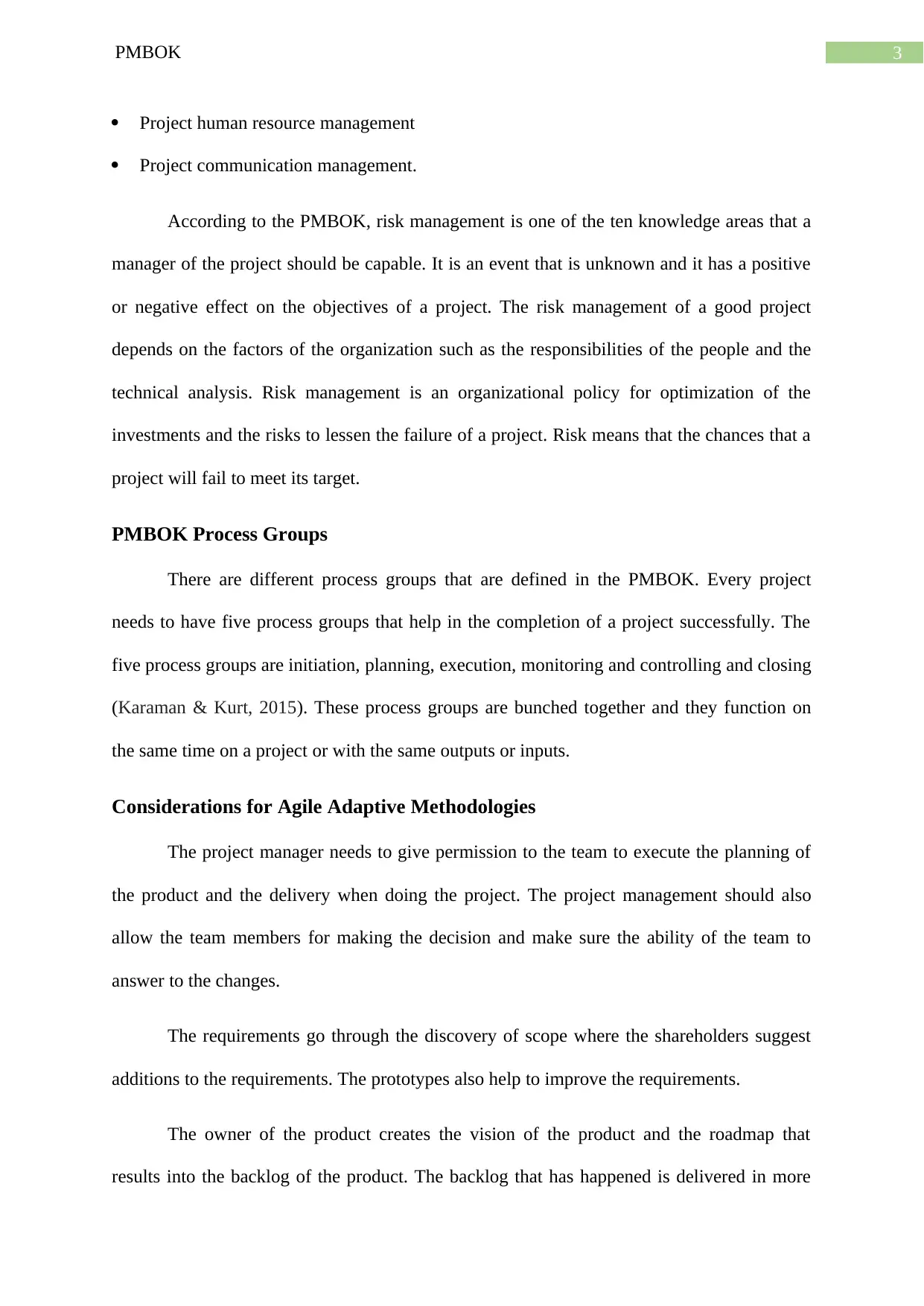
3PMBOK
Project human resource management
Project communication management.
According to the PMBOK, risk management is one of the ten knowledge areas that a
manager of the project should be capable. It is an event that is unknown and it has a positive
or negative effect on the objectives of a project. The risk management of a good project
depends on the factors of the organization such as the responsibilities of the people and the
technical analysis. Risk management is an organizational policy for optimization of the
investments and the risks to lessen the failure of a project. Risk means that the chances that a
project will fail to meet its target.
PMBOK Process Groups
There are different process groups that are defined in the PMBOK. Every project
needs to have five process groups that help in the completion of a project successfully. The
five process groups are initiation, planning, execution, monitoring and controlling and closing
(Karaman & Kurt, 2015). These process groups are bunched together and they function on
the same time on a project or with the same outputs or inputs.
Considerations for Agile Adaptive Methodologies
The project manager needs to give permission to the team to execute the planning of
the product and the delivery when doing the project. The project management should also
allow the team members for making the decision and make sure the ability of the team to
answer to the changes.
The requirements go through the discovery of scope where the shareholders suggest
additions to the requirements. The prototypes also help to improve the requirements.
The owner of the product creates the vision of the product and the roadmap that
results into the backlog of the product. The backlog that has happened is delivered in more
Project human resource management
Project communication management.
According to the PMBOK, risk management is one of the ten knowledge areas that a
manager of the project should be capable. It is an event that is unknown and it has a positive
or negative effect on the objectives of a project. The risk management of a good project
depends on the factors of the organization such as the responsibilities of the people and the
technical analysis. Risk management is an organizational policy for optimization of the
investments and the risks to lessen the failure of a project. Risk means that the chances that a
project will fail to meet its target.
PMBOK Process Groups
There are different process groups that are defined in the PMBOK. Every project
needs to have five process groups that help in the completion of a project successfully. The
five process groups are initiation, planning, execution, monitoring and controlling and closing
(Karaman & Kurt, 2015). These process groups are bunched together and they function on
the same time on a project or with the same outputs or inputs.
Considerations for Agile Adaptive Methodologies
The project manager needs to give permission to the team to execute the planning of
the product and the delivery when doing the project. The project management should also
allow the team members for making the decision and make sure the ability of the team to
answer to the changes.
The requirements go through the discovery of scope where the shareholders suggest
additions to the requirements. The prototypes also help to improve the requirements.
The owner of the product creates the vision of the product and the roadmap that
results into the backlog of the product. The backlog that has happened is delivered in more
Paraphrase This Document
Need a fresh take? Get an instant paraphrase of this document with our AI Paraphraser
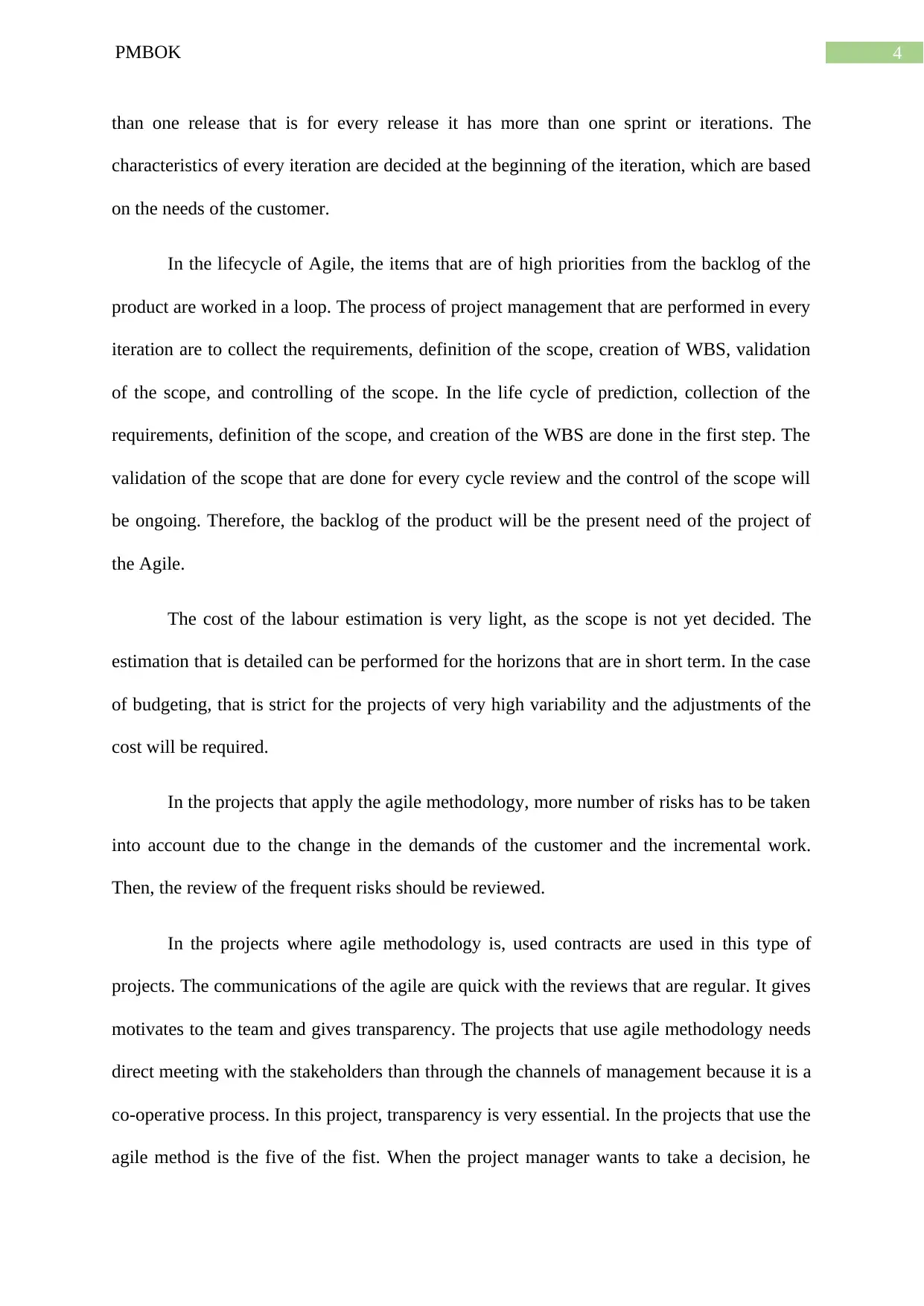
4PMBOK
than one release that is for every release it has more than one sprint or iterations. The
characteristics of every iteration are decided at the beginning of the iteration, which are based
on the needs of the customer.
In the lifecycle of Agile, the items that are of high priorities from the backlog of the
product are worked in a loop. The process of project management that are performed in every
iteration are to collect the requirements, definition of the scope, creation of WBS, validation
of the scope, and controlling of the scope. In the life cycle of prediction, collection of the
requirements, definition of the scope, and creation of the WBS are done in the first step. The
validation of the scope that are done for every cycle review and the control of the scope will
be ongoing. Therefore, the backlog of the product will be the present need of the project of
the Agile.
The cost of the labour estimation is very light, as the scope is not yet decided. The
estimation that is detailed can be performed for the horizons that are in short term. In the case
of budgeting, that is strict for the projects of very high variability and the adjustments of the
cost will be required.
In the projects that apply the agile methodology, more number of risks has to be taken
into account due to the change in the demands of the customer and the incremental work.
Then, the review of the frequent risks should be reviewed.
In the projects where agile methodology is, used contracts are used in this type of
projects. The communications of the agile are quick with the reviews that are regular. It gives
motivates to the team and gives transparency. The projects that use agile methodology needs
direct meeting with the stakeholders than through the channels of management because it is a
co-operative process. In this project, transparency is very essential. In the projects that use the
agile method is the five of the fist. When the project manager wants to take a decision, he
than one release that is for every release it has more than one sprint or iterations. The
characteristics of every iteration are decided at the beginning of the iteration, which are based
on the needs of the customer.
In the lifecycle of Agile, the items that are of high priorities from the backlog of the
product are worked in a loop. The process of project management that are performed in every
iteration are to collect the requirements, definition of the scope, creation of WBS, validation
of the scope, and controlling of the scope. In the life cycle of prediction, collection of the
requirements, definition of the scope, and creation of the WBS are done in the first step. The
validation of the scope that are done for every cycle review and the control of the scope will
be ongoing. Therefore, the backlog of the product will be the present need of the project of
the Agile.
The cost of the labour estimation is very light, as the scope is not yet decided. The
estimation that is detailed can be performed for the horizons that are in short term. In the case
of budgeting, that is strict for the projects of very high variability and the adjustments of the
cost will be required.
In the projects that apply the agile methodology, more number of risks has to be taken
into account due to the change in the demands of the customer and the incremental work.
Then, the review of the frequent risks should be reviewed.
In the projects where agile methodology is, used contracts are used in this type of
projects. The communications of the agile are quick with the reviews that are regular. It gives
motivates to the team and gives transparency. The projects that use agile methodology needs
direct meeting with the stakeholders than through the channels of management because it is a
co-operative process. In this project, transparency is very essential. In the projects that use the
agile method is the five of the fist. When the project manager wants to take a decision, he
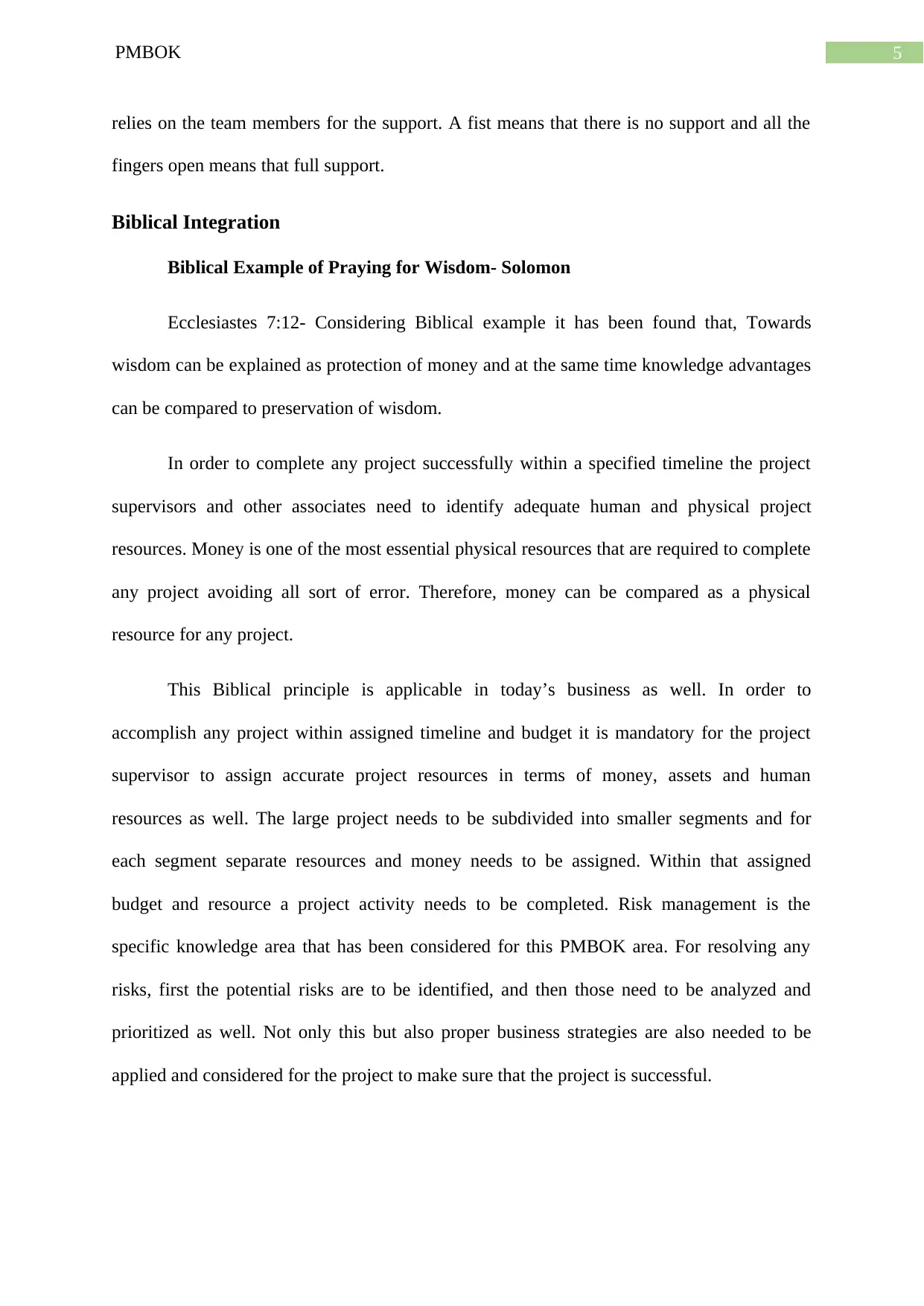
5PMBOK
relies on the team members for the support. A fist means that there is no support and all the
fingers open means that full support.
Biblical Integration
Biblical Example of Praying for Wisdom- Solomon
Ecclesiastes 7:12- Considering Biblical example it has been found that, Towards
wisdom can be explained as protection of money and at the same time knowledge advantages
can be compared to preservation of wisdom.
In order to complete any project successfully within a specified timeline the project
supervisors and other associates need to identify adequate human and physical project
resources. Money is one of the most essential physical resources that are required to complete
any project avoiding all sort of error. Therefore, money can be compared as a physical
resource for any project.
This Biblical principle is applicable in today’s business as well. In order to
accomplish any project within assigned timeline and budget it is mandatory for the project
supervisor to assign accurate project resources in terms of money, assets and human
resources as well. The large project needs to be subdivided into smaller segments and for
each segment separate resources and money needs to be assigned. Within that assigned
budget and resource a project activity needs to be completed. Risk management is the
specific knowledge area that has been considered for this PMBOK area. For resolving any
risks, first the potential risks are to be identified, and then those need to be analyzed and
prioritized as well. Not only this but also proper business strategies are also needed to be
applied and considered for the project to make sure that the project is successful.
relies on the team members for the support. A fist means that there is no support and all the
fingers open means that full support.
Biblical Integration
Biblical Example of Praying for Wisdom- Solomon
Ecclesiastes 7:12- Considering Biblical example it has been found that, Towards
wisdom can be explained as protection of money and at the same time knowledge advantages
can be compared to preservation of wisdom.
In order to complete any project successfully within a specified timeline the project
supervisors and other associates need to identify adequate human and physical project
resources. Money is one of the most essential physical resources that are required to complete
any project avoiding all sort of error. Therefore, money can be compared as a physical
resource for any project.
This Biblical principle is applicable in today’s business as well. In order to
accomplish any project within assigned timeline and budget it is mandatory for the project
supervisor to assign accurate project resources in terms of money, assets and human
resources as well. The large project needs to be subdivided into smaller segments and for
each segment separate resources and money needs to be assigned. Within that assigned
budget and resource a project activity needs to be completed. Risk management is the
specific knowledge area that has been considered for this PMBOK area. For resolving any
risks, first the potential risks are to be identified, and then those need to be analyzed and
prioritized as well. Not only this but also proper business strategies are also needed to be
applied and considered for the project to make sure that the project is successful.
⊘ This is a preview!⊘
Do you want full access?
Subscribe today to unlock all pages.

Trusted by 1+ million students worldwide
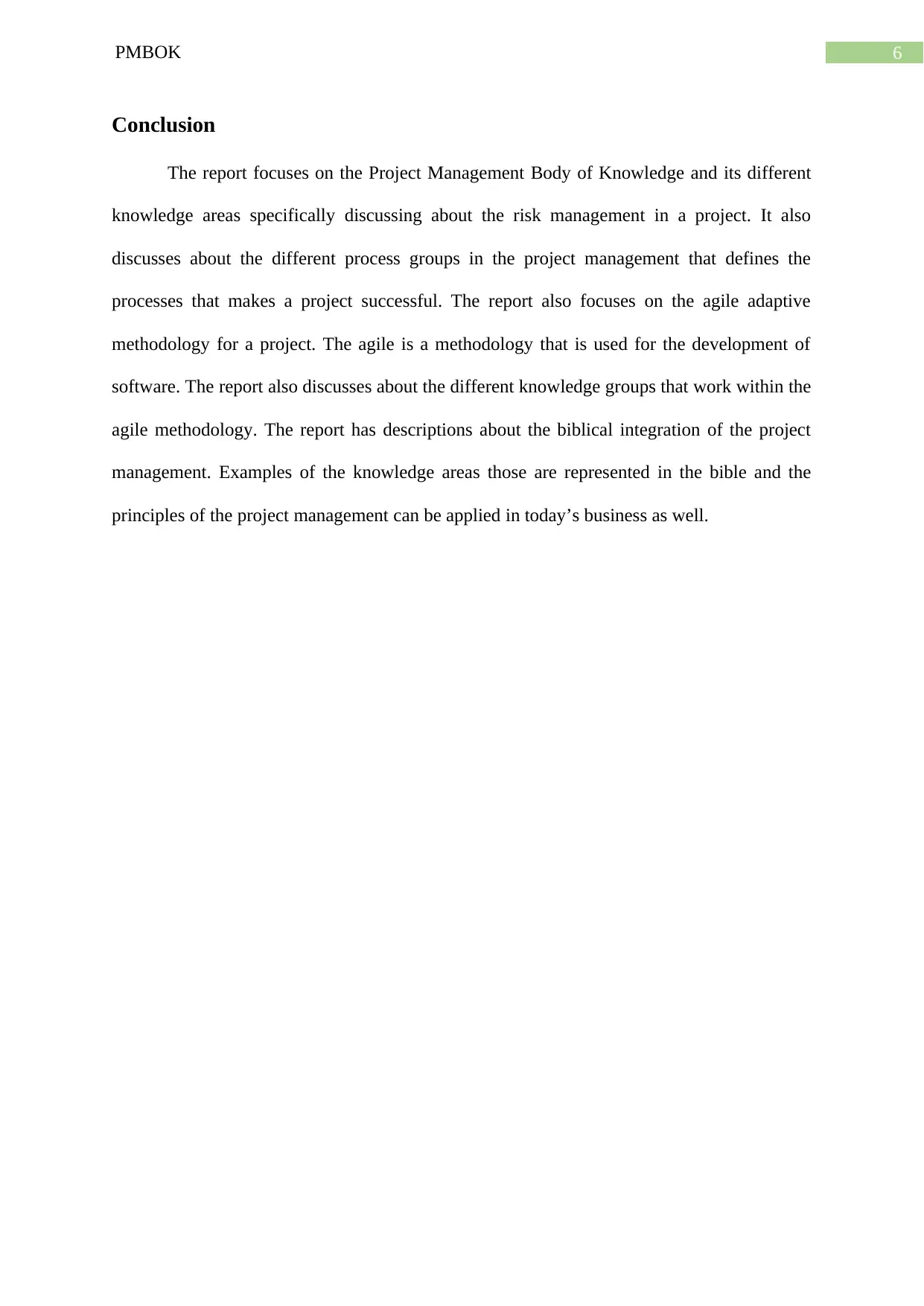
6PMBOK
Conclusion
The report focuses on the Project Management Body of Knowledge and its different
knowledge areas specifically discussing about the risk management in a project. It also
discusses about the different process groups in the project management that defines the
processes that makes a project successful. The report also focuses on the agile adaptive
methodology for a project. The agile is a methodology that is used for the development of
software. The report also discusses about the different knowledge groups that work within the
agile methodology. The report has descriptions about the biblical integration of the project
management. Examples of the knowledge areas those are represented in the bible and the
principles of the project management can be applied in today’s business as well.
Conclusion
The report focuses on the Project Management Body of Knowledge and its different
knowledge areas specifically discussing about the risk management in a project. It also
discusses about the different process groups in the project management that defines the
processes that makes a project successful. The report also focuses on the agile adaptive
methodology for a project. The agile is a methodology that is used for the development of
software. The report also discusses about the different knowledge groups that work within the
agile methodology. The report has descriptions about the biblical integration of the project
management. Examples of the knowledge areas those are represented in the bible and the
principles of the project management can be applied in today’s business as well.
Paraphrase This Document
Need a fresh take? Get an instant paraphrase of this document with our AI Paraphraser
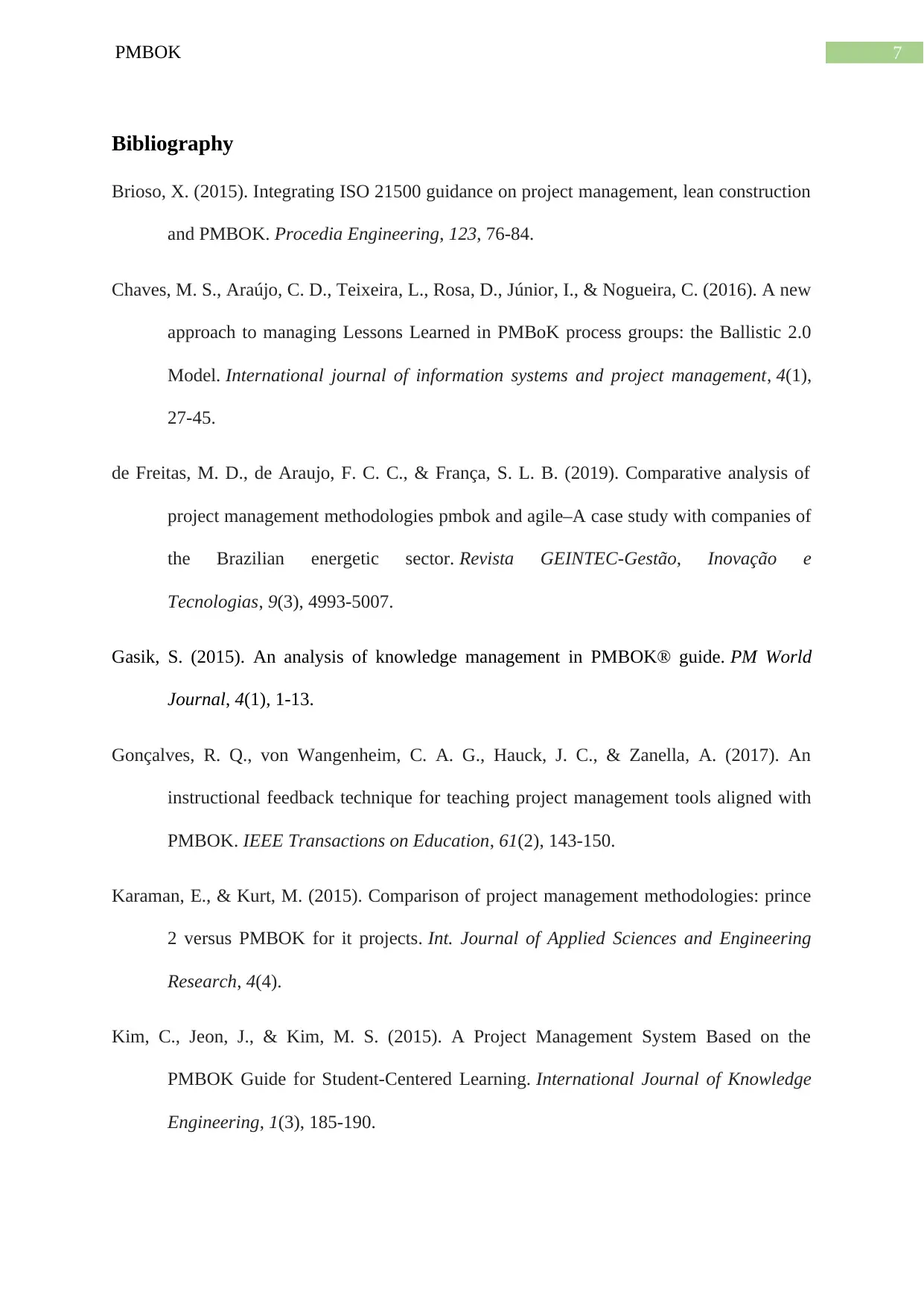
7PMBOK
Bibliography
Brioso, X. (2015). Integrating ISO 21500 guidance on project management, lean construction
and PMBOK. Procedia Engineering, 123, 76-84.
Chaves, M. S., Araújo, C. D., Teixeira, L., Rosa, D., Júnior, I., & Nogueira, C. (2016). A new
approach to managing Lessons Learned in PMBoK process groups: the Ballistic 2.0
Model. International journal of information systems and project management, 4(1),
27-45.
de Freitas, M. D., de Araujo, F. C. C., & França, S. L. B. (2019). Comparative analysis of
project management methodologies pmbok and agile–A case study with companies of
the Brazilian energetic sector. Revista GEINTEC-Gestão, Inovação e
Tecnologias, 9(3), 4993-5007.
Gasik, S. (2015). An analysis of knowledge management in PMBOK® guide. PM World
Journal, 4(1), 1-13.
Gonçalves, R. Q., von Wangenheim, C. A. G., Hauck, J. C., & Zanella, A. (2017). An
instructional feedback technique for teaching project management tools aligned with
PMBOK. IEEE Transactions on Education, 61(2), 143-150.
Karaman, E., & Kurt, M. (2015). Comparison of project management methodologies: prince
2 versus PMBOK for it projects. Int. Journal of Applied Sciences and Engineering
Research, 4(4).
Kim, C., Jeon, J., & Kim, M. S. (2015). A Project Management System Based on the
PMBOK Guide for Student-Centered Learning. International Journal of Knowledge
Engineering, 1(3), 185-190.
Bibliography
Brioso, X. (2015). Integrating ISO 21500 guidance on project management, lean construction
and PMBOK. Procedia Engineering, 123, 76-84.
Chaves, M. S., Araújo, C. D., Teixeira, L., Rosa, D., Júnior, I., & Nogueira, C. (2016). A new
approach to managing Lessons Learned in PMBoK process groups: the Ballistic 2.0
Model. International journal of information systems and project management, 4(1),
27-45.
de Freitas, M. D., de Araujo, F. C. C., & França, S. L. B. (2019). Comparative analysis of
project management methodologies pmbok and agile–A case study with companies of
the Brazilian energetic sector. Revista GEINTEC-Gestão, Inovação e
Tecnologias, 9(3), 4993-5007.
Gasik, S. (2015). An analysis of knowledge management in PMBOK® guide. PM World
Journal, 4(1), 1-13.
Gonçalves, R. Q., von Wangenheim, C. A. G., Hauck, J. C., & Zanella, A. (2017). An
instructional feedback technique for teaching project management tools aligned with
PMBOK. IEEE Transactions on Education, 61(2), 143-150.
Karaman, E., & Kurt, M. (2015). Comparison of project management methodologies: prince
2 versus PMBOK for it projects. Int. Journal of Applied Sciences and Engineering
Research, 4(4).
Kim, C., Jeon, J., & Kim, M. S. (2015). A Project Management System Based on the
PMBOK Guide for Student-Centered Learning. International Journal of Knowledge
Engineering, 1(3), 185-190.
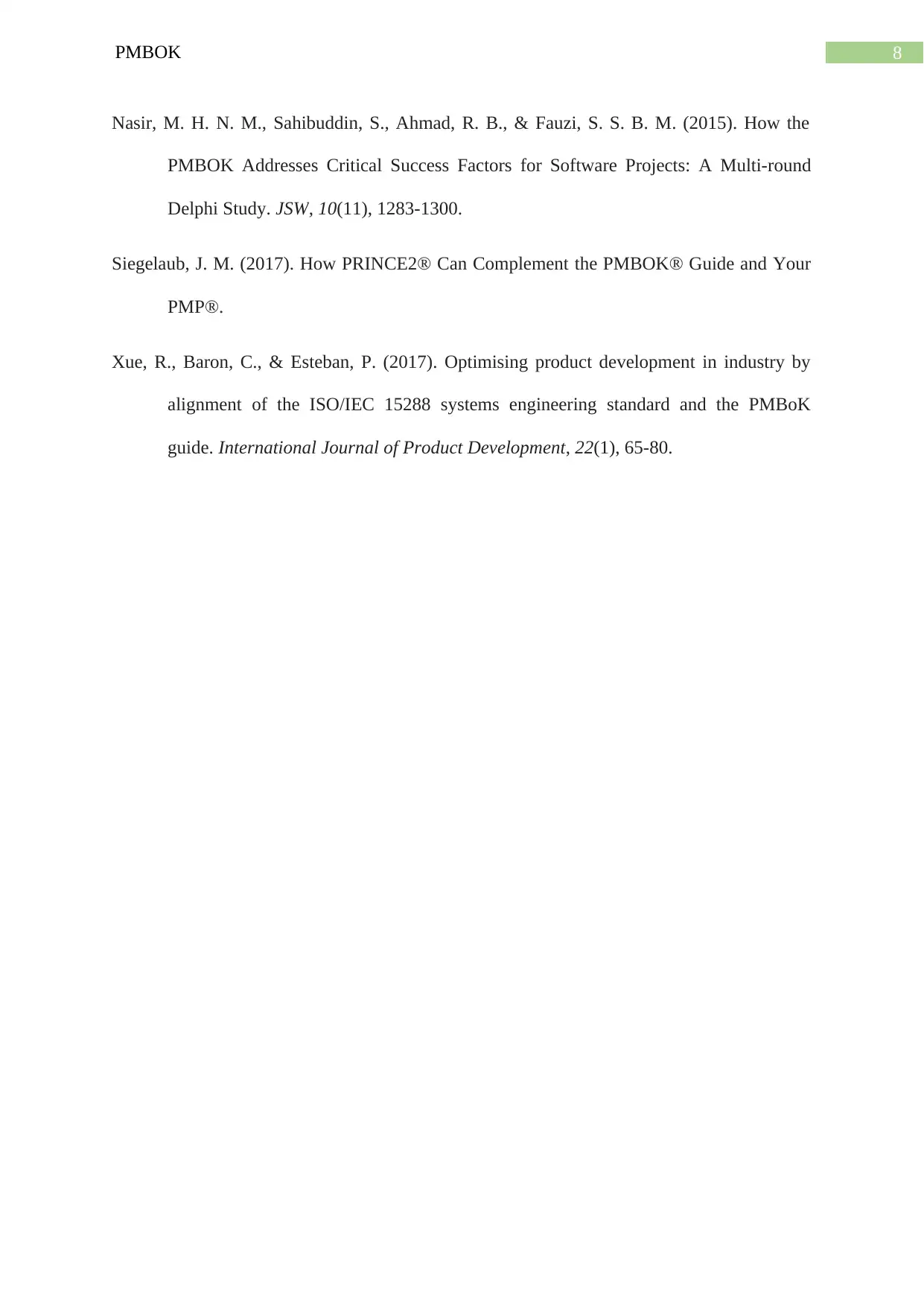
8PMBOK
Nasir, M. H. N. M., Sahibuddin, S., Ahmad, R. B., & Fauzi, S. S. B. M. (2015). How the
PMBOK Addresses Critical Success Factors for Software Projects: A Multi-round
Delphi Study. JSW, 10(11), 1283-1300.
Siegelaub, J. M. (2017). How PRINCE2® Can Complement the PMBOK® Guide and Your
PMP®.
Xue, R., Baron, C., & Esteban, P. (2017). Optimising product development in industry by
alignment of the ISO/IEC 15288 systems engineering standard and the PMBoK
guide. International Journal of Product Development, 22(1), 65-80.
Nasir, M. H. N. M., Sahibuddin, S., Ahmad, R. B., & Fauzi, S. S. B. M. (2015). How the
PMBOK Addresses Critical Success Factors for Software Projects: A Multi-round
Delphi Study. JSW, 10(11), 1283-1300.
Siegelaub, J. M. (2017). How PRINCE2® Can Complement the PMBOK® Guide and Your
PMP®.
Xue, R., Baron, C., & Esteban, P. (2017). Optimising product development in industry by
alignment of the ISO/IEC 15288 systems engineering standard and the PMBoK
guide. International Journal of Product Development, 22(1), 65-80.
⊘ This is a preview!⊘
Do you want full access?
Subscribe today to unlock all pages.

Trusted by 1+ million students worldwide
1 out of 9
Related Documents
Your All-in-One AI-Powered Toolkit for Academic Success.
+13062052269
info@desklib.com
Available 24*7 on WhatsApp / Email
![[object Object]](/_next/static/media/star-bottom.7253800d.svg)
Unlock your academic potential
Copyright © 2020–2025 A2Z Services. All Rights Reserved. Developed and managed by ZUCOL.





